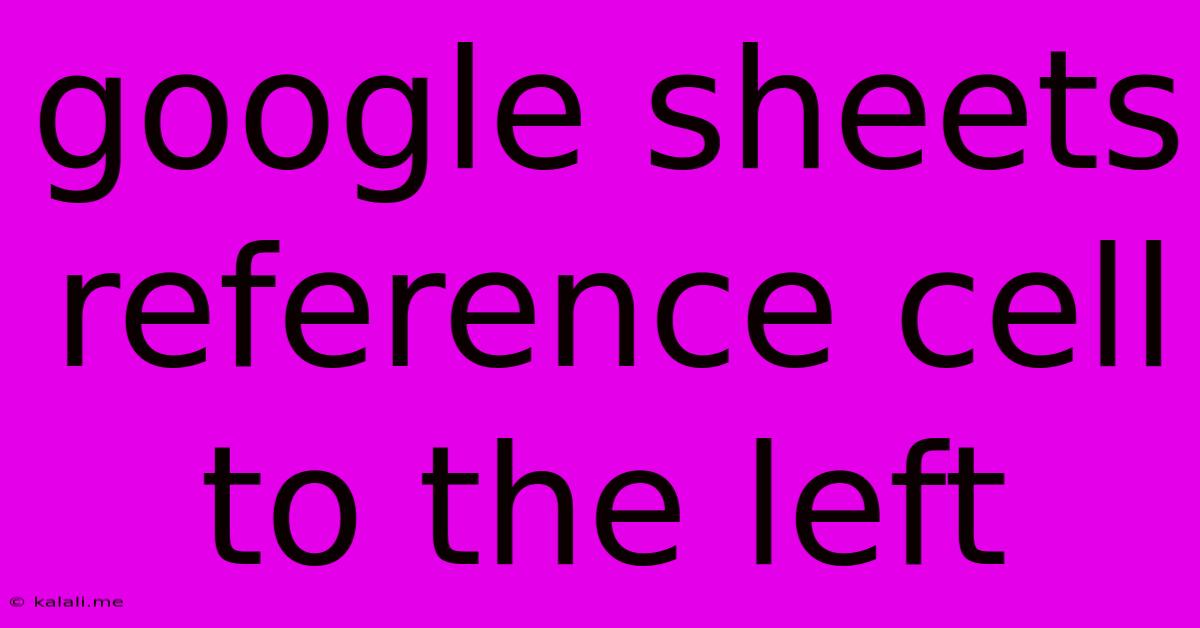Google Sheets Reference Cell To The Left
Kalali
Jun 01, 2025 · 3 min read

Table of Contents
Referencing Cells to the Left in Google Sheets: A Comprehensive Guide
This article will delve into the various methods for referencing cells to the left in Google Sheets, a common task in spreadsheet manipulation and data analysis. Whether you're a beginner or an experienced user, understanding these techniques will significantly improve your spreadsheet efficiency. We'll cover using the OFFSET function, relative references, and indirect referencing, each with its own strengths and applications.
Understanding Cell References in Google Sheets
Before we dive into referencing cells to the left, it's crucial to understand how Google Sheets addresses cells. Each cell has a unique address, identified by its column letter and row number (e.g., A1, B2, C10). Understanding these addresses is fundamental to using formulas effectively.
Method 1: Using the OFFSET Function
The OFFSET function is powerful and versatile. It allows you to reference a cell relative to a specific starting point. To reference the cell to the left, you would use a negative offset value. The syntax is:
OFFSET(reference, rows, cols, [height], [width])
reference: The starting cell.rows: The number of rows to offset (positive down, negative up).cols: The number of columns to offset (positive right, negative left).[height]: (Optional) The height of the range to return.[width]: (Optional) The width of the range to return.
Example: To reference the cell to the left of cell B5, you'd use:
=OFFSET(B5,0,-1)
This formula takes B5 as the reference, offsets zero rows, and offsets -1 column (to the left), effectively returning the value in cell A5.
Method 2: Using Relative References (Without Formulas)
For simple scenarios, relative referencing offers an intuitive and efficient solution. This method is particularly useful when copying formulas across rows or columns.
If you enter a formula in a cell that refers to a cell to its left (e.g., =A1 in cell B1), copying this formula to the right will automatically adjust the reference. For example, copying =A1 from B1 to C1 will change the formula to =B1.
Method 3: Using the INDIRECT Function
The INDIRECT function allows you to construct a cell reference as a text string. This offers flexibility but can be more complex. You'll need to use the ADDRESS function to create the cell reference dynamically.
Example: Suppose you're in cell C1 and want to reference the cell to the left (B1). You could use:
=INDIRECT(ADDRESS(ROW(),COLUMN()-1))
ROW()returns the current row number (1).COLUMN()returns the current column number (3).COLUMN()-1subtracts 1 to get the column number of the cell to the left (2).ADDRESS(ROW(),COLUMN()-1)constructs the address "B1".INDIRECT("B1")returns the value of cell B1.
This method is particularly useful when the offset needs to be determined dynamically based on other values in your spreadsheet.
Choosing the Right Method
The best method depends on your specific needs. For simple scenarios, relative references are often sufficient. The OFFSET function is versatile for more complex relative referencing, and the INDIRECT function is suitable for highly dynamic referencing needs. Consider the complexity of your spreadsheet and the flexibility required when choosing your approach. Understanding each method enables you to effectively manipulate and analyze data within Google Sheets.
Latest Posts
Latest Posts
-
Panic Fork Exec Bin Sh Operation Not Permitted User Namespace
Jun 03, 2025
-
How To Clean The Gas Oven
Jun 03, 2025
-
After Cutting Into Floor Joist Where To Secure Mending Plate
Jun 03, 2025
-
Why Does Cross Product Give Area
Jun 03, 2025
-
What Does Oso Mean In Spanish
Jun 03, 2025
Related Post
Thank you for visiting our website which covers about Google Sheets Reference Cell To The Left . We hope the information provided has been useful to you. Feel free to contact us if you have any questions or need further assistance. See you next time and don't miss to bookmark.